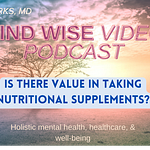
Welcome to the Mind Wise video podcasts, which present holistic mental health, health care, and wellness perspectives and information. I am your host, Ron Parks, M.D., writer, teacher, and consultant.
Today’s topic is: An “Ensurance Plan” for healthy aging, productivity, and vitality or how to structure a practical and sensible plan to maintain or enhance physical and mental health, longevity, and well-being?
There are reasonable choices for promoting health and longevity and preventing future disease and disability.
Scientific research studies of those who have aged successfully and been productive for many more years than the average have shown that similar achievable benefits are possible for others. You might wonder why more people are not following or ignoring beneficial choices. The finding that most don’t heed the growing knowledge and wisdom about living longer with more years of vitality and productivity is perplexing for most medical people, caregivers, and well-intentioned medical researchers and social scientists who continue to uncover remarkable findings.
I was contemplating where to start my article on health and longevity. While pacing in my warm, cozy basement office, perplexed, I spotted across the room on one of my bookshelves a closed blue and gold patterned box with a colorful oriental motif.
Kia’s profound gift
I remembered the warm and valued friendship I had with a chef and Chinese restaurant owner who was attending a course on macrobiotic nutrition, food choices, and cooking in the majestic western Massachusetts mountains. It was a popular trend then, and I was interested in exploring health alternatives. It was a valuable experience, but I mostly appreciated it because I met a new valued friend. As I remember, Kai first appeared as a happy and healthy man, perhaps in his early forties, lovingly supportive, inspiring to all he encountered, and a joy to be around, especially for my wife and me.
Kai was always devoted to the practices of the program’s well-known authority and primary teacher. He had the hope of gaining some improvement or reversal of a condition he had, of which I was unaware. Towards the end of the course, Kai was having some difficulty breathing and asked me to drive him down the mountain to the local hospital emergency room. Even though he was frightened by his discomfort, he embraced his plight as something he could overcome. He was confident that he could find the way to the best of his abilities and his traditional and naturally oriented way of life and self-care. We talked, sharing some of our deepest thoughts and convictions. There was a bond and a deep feeling of friendship in our urgent journey down the mountain to whatever his felt destiny was to be.
Kai told me that a tumor, small at first, was growing in his chest. He and his family have been following natural ways of supporting health and well-being for generations. He felt his path was his own and his choices would be the best for him. Once at the hospital, an x-ray showed a round cancerous growth interfering with his breathing. They recommended hospitalization and surgery and the treatments of the day. I encouraged him to at least consider. Kai was firm to continue his path and choices and returned to the program’s last days. We embraced when he left, and he gave me one of his prized possessions, two colorful, decorated metallic Chinese therapy balls that played musical tones when you rolled them in your hands. I tried to decline such an unexpected and generous gift. But he insisted in his warm and charming way.
I appreciated and accepted it as a special remembrance of our friendship and our time pursuing our mutual interest in health and longevity. These crafted wonders were not only charming but reputedly of value for their therapeutic, meditative, and relaxation enhancement. Kia’s wife informed me he died later that year, feeling true to himself, fulfilled, and peaceful. I can’t judge him for not taking the path and medical advice I probably would have. Apparently, something deeper influenced his choices, possibly that his survival wouldn’t have benefited from the intervention recommended.
The flow of life, influences, challenges, and choices
With the warm remembrance of my friend, I picked the Chinese therapy balls up out of their colorful box, rolled them gently in my hands with the sweet tones emanating from the interior of the hollowed spheres, and thought about the flow of life and the constant changes and challenges that confront us. I was reminded of the powerful influences that affect our choices. We hope our decisions will alter our destinies and counter the influences of past poor “karmic” choices and actions. Then, I launched into my writing with a respectful reverence for the topic and acknowledgment of the limitation of what we think we know and what is unknowable and that any decisions we make may be more consequential than what is in our awareness.
The reality remains that while some of these valuable interventions for healthy life and longevity might be obvious, understandable, and doable for some, the beneficial interventions are the lowest priority and focus for many others. Unfortunately, most either reject or don’t know or are prevented from acting on healthy alternatives because of socioeconomic factors, lack of resources, and education. Unduly influenced by others is a significant factor driven by false information and the marketing of unhealthy but enticing consumer goods, such as those that contribute to obesity and a sedentary lifestyle.
Even when there has been a severe social and economic disadvantage, poverty, affliction by disease, disability from injuries, or illness related to family genetics, some people have, against the disadvantages, optimized their time alive with life-sustaining and enhancing choices. Studying the actions taken when there has been obvious benefit has been worthwhile in finding and documenting the best alternatives for those with unfortunate circumstances, high risks, and challenges.
Choosing the best options for mental, emotional, physical, and spiritual health
The positive health and longevity choices, at least to the best of current knowledge and scientific investigation, stem from studies and research in specific illnesses and significant public health issues, as in the work on preventing medical illness, cardiovascular, heart disease, mental decline, and degenerative brain disease. When specific degenerative health conditions are carefully examined, such as dementia and Alzheimer’s, valuable health interventions often apply and are beneficial to other mental, emotional, and physical forms of illness, where there is a loss of capacity and vitality at a younger age than expected.
Many areas of investigation have given insights and clues into the matter of choosing the best alternative to relieve pain and suffering, optimize health and longevity, and help recovery from illness or substance use difficulties. Two current areas of interest may highlight strategies shown in scientific investigation and clinical reports that could answer what many seek as alternatives for prevention and maintaining healthy aging, working capacity, and vitality. The first would be from the ameliorative and preventative approaches that have shown benefits in substance use disorder and the deadly overdose problem in opioid use disorders. The brain’s addictive propensities are an essential part of the conversation, especially in terms of behaviors that are a detriment to our health and well-being. Understanding substance abuse and addictive behavior might also illuminate why we have destructive habits and don’t follow or make wiser decisions.[i]
Using opioids has grown beyond medical use for pain management to abusive use of derivatives such as heroin and fentanyl, now morphed into an epidemic of overdose deaths. The second would be the preventive strategies shown in current medical research and clinical studies for the dreaded degenerative and debilitating illnesses that afflict the brain and nervous system. Alzheimer’s disease, for example, is a common cause of loss of brain function, cognitive impairment, memory loss, and dementia.[ii]
Looking at causation in Alzheimer’s and substance abuse disorders, there are usually some inherited or genetic factors, as with the discovery of other family members with similar impairments or illnesses. A person can have the genes or propensities for one of these disabling illnesses that compromise longevity and quality of life. Still, they don’t occur or express themselves unless there is some trigger, such as something a person might do or not do, such as a chemical or substance exposure or something present or lacking in lifestyle as too much stress or not taking part in beneficial activities.
Family genetics
I was first exposed to the idea of family genetics or inheritance when I was fourteen years old when my Uncle Jack walked me to the back of a Baltimore cemetery during a funeral for a family member. He showed me the tombstone of my grandfather.
My uncle says, “Pay attention to how the tombstone is tilted far to the left. It is a reminder that your grandfather was a drunk and made all our lives miserable, especially after he deserted my mother and all of us kids. Your father was the oldest and, at fourteen years old, had to take a dangerous job in shipyards to help support the family.” Genetic research has shown that there is a propensity for succeeding generations to have a higher propensity for developing alcohol use disorders. A more immediate adverse impact occurs on the children and family when one or both parents have alcohol use disorder, as documented by health care and social scientists.
My dad certainly had his emotional struggles to grow into adulthood and independence because of his early childhood traumas related to his alcoholic father, as did his brothers and sisters. Dad rarely talked about it.
Geneticists call triggers or influences that turn on a gene’s action and expression or occurrence of the disease epigenetic factors. I’ve certainly seen in my medical career when very aggressive cancer occurred after a person became weakened by several significant stresses, life setbacks, and losses. Of course, there are many unexpected diseases, some at an earlier age than expected, where there is no family history, genetic propensities, or identifiable lifestyle issue. So, we continue to observe, monitor, measure, and make predictions and provide the best-studied strategies and recommendations to prevent or lessen pain, suffering, and disease. I realize, with humility, that our medical science is far from knowing all that will be knowable in the future. However, I feel strongly that preventable strategies are essential to consider, given the significant advancement of our knowledge, wisdom, and research.
Strategies for prevention
Successful strategies for prevention and amelioration (recovery, improvement, or reduction in pain or suffering or disability) that are evidence-based on research and population studies for specific illnesses and disabilities have cross applications and shown successes in other related and non-related conditions. From such information, it is possible to develop a more extensive personal overall program focusing on vital specific actions that are doable for the individual and necessary to build a comprehensive prevention strategy. A developed program would also give “ensurance” or confidence in the future that preventing adverse conditions or improving or recovering from existing medical, emotional, or mental health problems would be highly likely.
Tips and Points to Ponder for disease prevention, optimizing health, longevity, and recovery:
An “ensurance plan”
1. I have an older brother who spent most of his career developing and running an insurance agency. I understood that insurance products were like a safety net for providing financial help after an accident, injury, or death. Insurance products or contracts protect someone from future losses, such as damage, theft, illness, or death, in exchange for a premium payment. The concept of an insurance plan can be re-imagined and applied to developing a personal “ensurance plan” to ensure a better, healthy future. Such an undertaking is best accomplished in collaboration with someone experienced in preventive and holistic health care. Working collaboratively with a skilled and knowledgeable other can be a way out of being stuck in counterproductive ideas and habitual responses that contribute to future premature decline or persisting relapses of a current or reoccurring condition;
2. I like the idea of an “ensurance plan.” The term ensurance is preferred, as it implies ensuring that an outcome would most likely occur, be achieved, or become a reality. Insurance generally refers to a policy, program, or contract that provides financial protection against certain risks. Ensurance implies making sure that something is protected or safe. In the insurance industry, ensurance can denote measures taken to ensure something is done correctly or to safeguard against potential problems related to risk management and safety[iii];
3. Ensurance strategies, as I conceive it, would include a macro and micro level. The macro level, for example, would comprise activities you would like to add, remove, or lessen that you are doing or have done in the past that have been beneficial and that you would like to continue in a consistent program.
A. Macro-level activities or areas for consideration are:
a. Spiritual practices—such as mindfulness, meditation, yoga, tai chi, loving-kindness, and gratitude;
b. Insight, dream, or other journaling for reflection and insight;
c. Lifestyle changes, such as exercise, nutrition, support and social network, and career work fulfillment;
d. Activities in place that can be accessible to ensure care and protection when triggers or compounding situations arise and relapse is a concern, such as having a regular therapist, 12-step programs with a sponsor, social and nurturing, therapeutic safety net available, recreational, sports programs, groups, or retreat or residential program to get respite and recovery away from overload or toxic situation.
e. An important caveat is that in developing a successful and enduring plan, it may mean, rather than adding activities and practices, to eliminate or reduce the many things already felt as necessary that contribute to overload or overwhelm, which are unnecessary, non-essential, life draining pursuits—so less, sometimes very much less, might be the key. With careful selection and discernment, one will discover what is most vital for sustaining, recovery, and thriving.
B. Micro Adjustments:
a. What areas seem problematic or areas that need fine tuning: environmental sensitives, nutrition, restorative sleep, exercise, and recreation program;
b. Areas that need more consistency or to be addressed, such as family, children, and disruptive situations;
c. Keep a daily record for self-monitoring, reflection, and insight - pick four items, such as sleep, mood, exercise, journaling insight, gratitude, breath work, or meditation practices. Rate each chosen item daily: 1 to 4 (25% of optimal, best intentions, or efforts to 100% or optimal).
4. An ensurance program would intend to put a protective framework or mechanisms in place to ensure you have the proper resources, reserve, and support when unanticipated events or triggers occur. When adequately applied, the person might avoid future ill health and disability, premature aging, and loss of vitality and functional capacity. With relapse or recurrence of illness and its telltale symptoms, such as seen in a sensitive, over-reactive, or vulnerable nervous system, such as seen in the mood cycling of bipolar disease or Post Traumatic Stress Disorder when past significant trauma, the intention would be “to inoculate” or “ensure” you to prevent or minimize severe and painful recurrences or minimize the instability, cycling, and recurrence.
5. The body-mind has a naturally strong inclination to heal, get back in balance, and be healthy, at least most of the time, so a structured, achievable plan of action, to do now to reduce vulnerability now and avoid future health risks should be the highest priority for everyone. Some essentials to building a program are to have activities or ingredients that will nurture and increase the body-mind resistance to unexpected or overwhelming circumstances, plus having resources such as a significant other or a therapist as a backup or support when needed. It is doing consistent activities that will increase mental, emotional, and physical reserve and the capacity to recover or have the endurance to sustain recovery and healing. Success is more likely in a developed personalized program when carried out consistently over time.
6. The structured, intentional program could then settle in as a positive brain habit (as the ninety days to work on sobriety in a step program). The best elements for such a program include past activities that were tried and experienced with positive results, plus what has been recommended by trusted and experienced collaborators or consultants. I will pick up where we left off here and continue in my subsequent posts to develop sensible and strategic health, vitality, and longevity programs for the motivated and interested.
Getting unstuck and gaining insight, wisdom, and humbleness
If I get stuck in my writing, I will reflect on my personal and professional experiences over the years or walk across my office room, see the two boxed colorful Chinese therapy balls, remember my friend Kia, roll them in my hand, and maybe gain some wisdom, insight, and humbleness to move on with vital and challenging topics.
I appreciate your interest. Your ideas and comments are welcome. Please share with others. Subscribe to my Substack newsletter and podcast at www.inmindwise.com.
All content is created and published for educational purposes only and should not be construed as a substitute for professional or medical services or guidance. Always seek your healthcare provider’s care regarding medical or mental health conditions. This communication is not intended to provide a medical diagnosis, recommendation, treatment, or endorsement. Thank you.
[i] Addiction article by Dr. Parks - https://www.inmindwise.com/p/addiction-survival;
[ii] Dementia Society of America® | Definitions;
https://www.nia.nih.gov/health/alzheimers-and-dementia/preventing-alzheimers-disease-what-do-we-know;
[iii] https://thecontentauthority.com/blog/assurance-vs-ensurance










